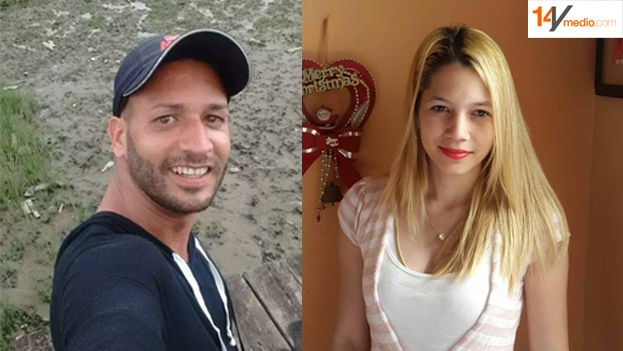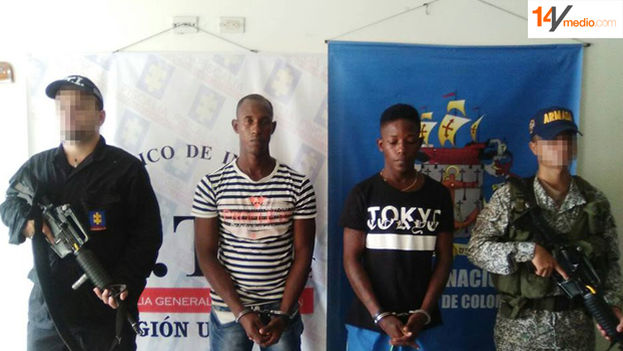
![]() 14ymedio, Mario Penton, Miami, 18 September 2016 — “With the money from the sale of my mother’s house, we bought the death of my brother.”
14ymedio, Mario Penton, Miami, 18 September 2016 — “With the money from the sale of my mother’s house, we bought the death of my brother.”
Spoken with indescribable bitterness, these were the words of Edgardo Nordelo Sedeño, brother of Dunieski Eliades Lastre, age 25, murdered in Colombia on 8 September along with the young woman Edelvis Martínez. Both were Cubans and were trying to sneak through the jungles and borders that separated them from their goal: the United States and their dream of a free life.
Although Forensic Medicine has ruled out for the moment the alleged rape of Edelvis Martínez, the prosecutor has revealed gruesome details in the tragic ends of these young migrants trying to reach the United States.
Edelvis Martinez Aguilar was an accountant for a paladar, a private restaurant in Havana. She left with her boyfriend Liover Santos Corria, 35, heading to Guyana. After crossing Venezuela and Colombia they met up with Eliades Dunieski who apparently traveled to Capurgana to get to the Darien jungle. That day, two of them were killed in a Colombian swamp.
“We can not say that Martinez had been raped, at least there is no macroscopic evidence of that. Forensic Medicine did the research, collected samples from the body and are undertaking a conclusive analysis of the issue,” an official with the Columbian Attorney General’s office told 14ymedio, who asked to remain anonymous.
“We have found clear signs of torture in both victims before the murder,” he added.
The alleged perpetrators were identified as Johan Estiven Carreazo Asprilla, alias ‘Play Boy’, age 20, and Carlos Emilio Ibargüen Palacio, age 26. According to Santos, the only survivor, the Cuban migrants paid $1,500 to be taken to Panama, but once they arrived at the Gulf of Uraba the smugglers demanded more money. When the Cubans explained that they had no cash, the boaters murdered them with knives and hid their bodies tied to a tree trunk at the bottom of the Matuntugo Swamp. Santos saw his girlfriend beheaded after she was raped, he says, but he was able break loose and escape from the crime scene.
“The young man is under protection on a Navy ship because we fear for his safety,” said the source in the Colombian Attorney General’s office. According to the investigator, it is very likely that there are more people involved in the murder of the Cubans so it is necessary to protect the main witness.
“The boatmen pleaded not guilty, but the prosecution has sufficient evidence to incriminate them,” the source explained.
Following the arrest of suspects involved in the crime, a search of the travel backpacks of those killed found cell phones, cash and clothes. Also seized were a firearm, a smoke grenade, several pieces of clothing related to the crime scene and a wooden boat in which was one of the shoes of the murdered woman.

The identity of those murdered was corroborated by Cuban authorities. According to what this newspaper has been able to confirm, the United States embassy in Colombia has taken up the issue and expressed interest in granting asylum to the survivor.
Although the Cuban consulate in Bogota declined to comment on the matter, the Colombian Foreign Ministry said they have been in contact with the relatives of those killed through diplomatic representatives in Miami to advise them on the procedure to claim the bodies.
“Colombia will provide all the help needed for repatriation, but this is a matter for the family or the Cuban Embassy. Family members can delegate power to the embassy or manage the process independently,” said the Foreign Ministry.
14ymedio spoke with the relatives of the victims in Cuba and in the United States. For Maria Isabel Aguilar, the mother of Edelvis Martinez, her main concern is that so far she doesn’t know what the process is for repatriating the body of his daughter.
“We went to MINREX (Ministry of Foreign Affairs) but there they told us to wait for the authorization of the Colombian government to bring the bodies. We don’t know how to bring my daughter. I only want her here with me,” she said.
Dunieski Eliades Lastre’s brother, Edgardo Nordelo Sedeño, said that the cost to repatriate the bodies is around $3,000 each. The family members who had to privately arrange the trip to MINREX explained via a telephone call that although the Cuban government authorized the entry of the bodies, they will not pay for the costs of bringing them home.
“Dunieski was my younger brother, my mother’s delight. So much so she wanted to sell her house to be able to pay for the ticket so he could have a better life,” explained Nordelo, who arrived in the United States last February by way of Ecuador.
“I don’t understand the motive for the murder. The other boy … told me that my brother told them, ‘Don’t kill me, I’ll give you the number of my brother in the United States so he can send you money. It wasn’t for money. I don’t understand why they did it,” he said.
Eliades Lastre managed to make the crossing from Guyana to Turbo in one week. According to his relatives he had a good trip until he reached the Colombian coast.
“Because of the bad weather they couldn’t take them to where the other coyote was. They returned to the home of a guide and a few minutes before leaving the house where they were hiding, he wrote me to tell me. That was the last time we communicated,” recalls Edgardo Nordelo.
“The blame for the death of our family members belongs to those who pushed them to the jungle and made them seek out coyotes to achieve their dream of freedom,” he said.
